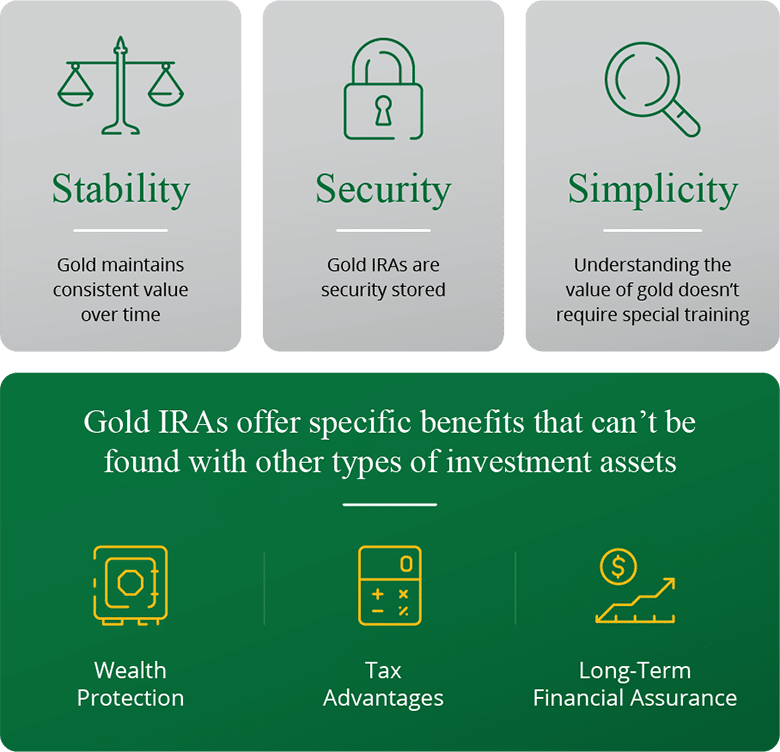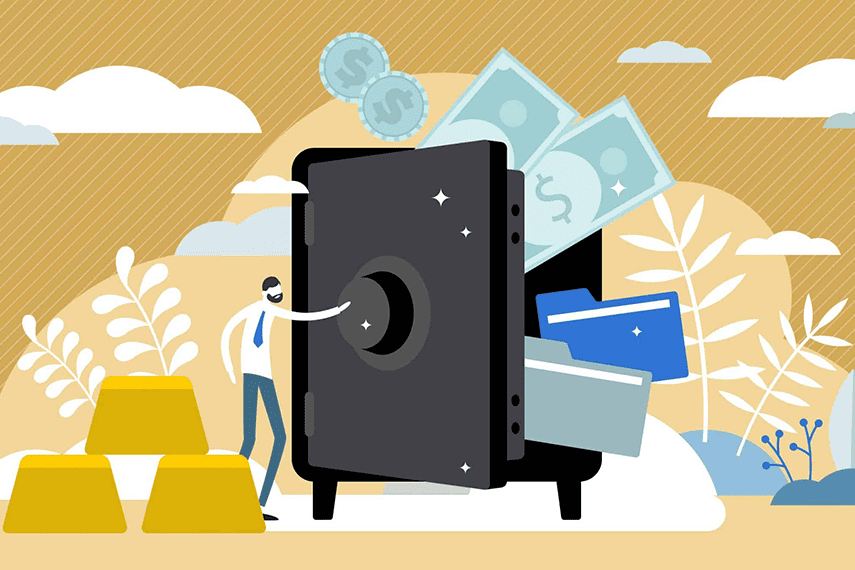What Is a Gold IRA?
As a retirement saver, you’re constantly faced with choices and tradeoffs. You want your retirement portfolio to make big gains, but you understand in the back of your mind that your portfolio can be subject to huge losses.
Many successful savers are those who protect their portfolios from major losses, not necessarily those who make the biggest gains. As Warren Buffett famously said, “the first rule of investing is never to lose money, and the second rule is never to forget the first rule.”
“The first rule of investing is never to lose money, and the second rule is never to forget the first rule.”
One time-honored way of protecting investments against loss is by investing in gold. Investors have sought the safety and security of gold for centuries, and today is no different.
When stock markets crash, or when fears of market weakness emerge, many investors rush to the safe haven of gold. But even outside times of financial difficulty, investing in gold can be a smart way to diversify your portfolio, protect your wealth, and make solid gains.
One popular method of investing in precious metals is through a gold IRA. Gold IRAs offer the same tax advantages of conventional IRAs, but allow investors to protect their retirement savings with tangible physical gold, which can help safeguard them against volatility in financial markets.
Given gold’s reputation for long-term stability, it is a sought-after asset for investors looking to protect and diversify their investments. If you’re looking to protect your retirement savings, ensure that you have enough to live comfortably in retirement, and pass money on to your heirs, keep reading our beginner’s guide to a gold IRA to find out more about the numerous advantages of a gold-backed IRA.
What Is a Self-Directed Gold IRA?

Unlike conventional IRAs with which you may be familiar, a gold IRA is a type of self-directed IRA. Before we address gold IRA investing, it is important to understand the basics of a self-directed IRA.
A self-directed IRA (SDIRA) is an IRA that gives you greater control and flexibility over the assets you invest in. It allows you to invest in alternative assets that aren’t found in most conventional IRAs. While self-directed IRAs require the use of a custodian who administers the account, you as the account holder actually get to manage the account directly.
Some common forms of alternative investments allowed in a self-directed IRA include:
- Real estate
- Promissory notes
- Gold, silver, and other precious metals
- Cryptocurrency
- Mineral rights and water rights
- Commodities
A gold IRA is simply a type of self-directed IRA that focuses on investing in precious metals such as gold coins and gold bars.
How Does A Gold IRA Work?
A gold IRA allows investors to invest in gold and other precious metals while still enjoying the same tax advantages of an IRA retirement account. Just like conventional IRAs, a gold IRA can be a traditional IRA in which investors use pre-tax dollars to invest in gold, or a Roth IRA in which they use post-tax dollars to invest in gold. Those with SEP or SIMPLE IRAs can also invest their retirement savings with a gold IRA.
A common method of funding gold IRAs is through rollovers or transfers from existing retirement accounts such as a 401(k), 403(b), TSP, IRA, or similar account into a gold IRA. This allows investors to lock in gains they may have made in their current retirement accounts and transfer that wealth into precious metals, which can provide more protection and stability.
Gold is a tangible asset that anyone can own and hold, and it offers stability against inflation, financial turmoil, and economic downturns. Thanks to provisions in the tax code, investors can invest in gold through a gold IRA, allowing them to gain all the same tax benefits as a conventional IRA.
There are many advantages to including gold, silver or other precious metals in your IRA portfolio, including:
- Stability for your investment portfolio;
- Lessening risk as you age and plan for retirement;
- Locking in gains you’ve made and transfering that wealth into precious metals.
Investors can contribute to a new gold IRA account or, more commonly, roll over a portion of their current retirement accounts (401(k) rollover) into a gold IRA to diversify their portfolio. With the risk of recession being ever present, there really isn’t a bad time to consider precious metals like gold as an investment.
What Is a Gold IRA Rollover?
A rollover IRA is a term for an individual retirement account (IRA) that is funded by moving funds from a 401(k), 403(b), TSP, or similar retirement account into an IRA. The main difference between a 401(k) and an IRA is that an IRA is normally opened by an individual, whereas a 401(k) is offered by an employer.
With a rollover IRA, investors can use existing retirement funds to take advantage of a broader range of investments than are available through 401(k) investments alone. And by investing in a self-directed IRA, you have even more options for investments, such as a gold IRA.
Rollover IRAs are most often created when changing jobs or retiring, as they allow employees to move their current 401(k) or other retirement account balances into an IRA account that will offer a better array of investments and potentially superior performance.
When performing an IRA rollover, funds from existing tax-advantaged accounts can be rolled over into a new IRA tax-free. You can even roll over funds from multiple retirement accounts into a single self-directed IRA, making it easier for you to consolidate and manage your retirement savings.
With a gold IRA rollover, investors can minimize the tax impact of their gold assets too, since distributions are normally subject to ordinary income tax rates. Particularly for those in lower tax brackets, that can result in gold held in an IRA being taxed at a lower rate than if it were not in an IRA. And for those investors who invest in a Roth gold IRA, they won’t be taxed at all on the gains on their gold investments.
What Is a Self-Directed IRA Custodian?
Like any other IRA, your self-directed gold IRA needs to have a custodian per IRS regulations. Your gold IRA custodian is responsible for administering your account and ensuring that all laws and regulations are followed to avoid penalties. Additionally, your gold IRA assets will be stored at a bullion depository, ensuring that your gold remains safe and secure.
Most IRA custodians are typically banks, insurance companies, brokerage firms, or mutual fund companies. Many of these firms don’t offer self-directed IRA options, so if you want to start a gold IRA you would need to find a custodian who specializes in precious metals investing.
Goldco works with established gold IRA custodians to ensure that our customers are able to start a gold IRA and find a self-directed IRA custodian with little difficulty. Choosing a custodian with knowledge of self-directed gold IRAs will help you ensure that your gold IRA assets are properly administered so that you don’t fall afoul of IRS regulations.
What Is Portfolio Diversification
Diversification is a strategic way of managing your investment portfolio to include various types of investments to reach specific financial goals over the long term. A well-diversified investment portfolio can offer you the potential for improving returns and protecting your principal without subjecting yourself to unnecessary concentration and risk.
Loading up on one stock or one industry could be costly if that stock or industry suddenly plummets. Likewise, reacting suddenly when the market changes can lead to knee-jerk investment decisions that don’t benefit you in the long term.
A diversified retirement portfolio can’t always offer large gains or prevent losses, but it is a strategy that some personal investors, financial planners, and fund managers use to create balance – and one way to effectively diversify can be by investing in gold and silver.
Learn More About Diversifying with Gold and Silver with the Free Wealth Protection Guide

Learn More About Diversifying with Gold and Silver with the Free Wealth Protection Guide

The Precious Metals Strategic Edge: Portfolio Diversification
If you’re like many investors, you probably dream of a safe and comfortable retirement. It’s why you’ve worked hard, saved, and invested for so many years. But you probably also know that your retirement savings could disappear in an instant in the event of a stock market crash or a severe recession.
You don’t want to leave your investment portfolio at the mercy of volatile financial markets that can put a major dent in your savings, which is why taking control of your future by investing in a gold IRA can be a good option for protecting and diversifying your investment portfolio. Investing in physical gold through a gold IRA can give you:

- Stability: Gold has consistently grown in value and maintained its purchasing power over time. While the US dollar has lost over 97% of its value since 1913, the price of gold has increased over 9,000%. Silver has fared well against the dollar too, with the silver price increasing over 4,500% since 1913.
- Security: The gold that you own in your gold IRA is securely stored at a bullion depository. You can take a distribution of either cash or gold from your gold IRA whenever you want, subject to any applicable taxes and IRS regulations, and after age 59½ those distributions are penalty-free.
- Simplicity: Understanding the value of gold doesn’t require special training, and you can easily check daily gold prices on your own.
Additionally, gold IRAs offer specific benefits that can be superior to those of other types of investment assets. These include:
- Wealth Protection: Gold has consistently grown in value over time, whereas the US dollar has consistently weakened over time through inflation and currency devaluation.
- Tax Advantages: Use pre-tax dollars to invest in gold, accrue tax-free gains, and only pay taxes upon distribution, just like a conventional IRA. Even better, you can learn how to diversify your 401(k) or IRA by rolling over existing assets to a gold IRA.
- Long-Term Financial Growth: Investing in gold can be a great long-term choice because it holds its value against inflation and can help protect portfolio value during times of recession.
- Financial Control: Diversifying your assets with a gold IRA puts you in control of your wealth.
Are Gold ETFs a Good Way to Diversify an Investment Portfolio?
Some investors have turned to popular gold exchange-traded funds (ETFs). ETFs offer you the ability to invest in a number of different assets, some of which you may otherwise have difficulty investing in. This has been seen as a potential way to diversify an investment portfolio, since ETFs open up the range of investment options to allow ordinary investors to enter new markets.
Unfortunately, there are several drawbacks to gold ETFs that can make them a less than ideal choice if you’re considering investing in gold:
- You don’t own the gold in a gold ETF: You actually only own the shares in a fund, which owns a certain quantity of gold. Share prices can fluctuate not only because of changes in the price of gold, but also based on whether investors decide to liquidate their shares.
- You can’t take physical delivery of gold: Except for some investors who own millions of dollars worth of shares, most gold ETF investors are not able to take delivery of the physical gold owned by the ETF. That’s why it’s important to look at ETF contracts and prospectuses before investing.
- Custodial arrangements are opaque: Custodians for gold ETFs can also contract with sub-custodians, which can make it hard to track who is holding the gold, where it is located, and whether or not it is otherwise encumbered.
- Taxes and fees: Fees associated with fund managers, listings on exchanges, custodial storage, and sales of fund assets can add up and may trigger certain tax consequences.
- Shares may or may not have sufficient gold backing: Funds may sell gold to meet expenses, which means shares may not be backed by as much gold as you thought.
Precious Metals Price Growth
While it may seem hard to believe, the history of gold as a freely-priced metal traded on world markets is relatively short.
Sure, gold has been bought and sold around the world for millennia, but for much of that time it was the basis for world currencies, often in a fixed price relationship with silver. Only after the link between gold and currencies was broken was gold able to shake off government efforts at fixing the gold price.
Until 1900, the US dollar was defined as a specific weight of silver. From 1900 on, the dollar was defined as a specific weight of gold, which worked out to be $20.67 per troy ounce of gold.
When FDR nationalized all gold and forbade private ownership of gold, he unilaterally devalued the dollar, with gold being valued thereafter at $35 an ounce. That $35 per ounce official price lasted until August 15, 1971, when President Nixon closed the gold window, severing the last official link between the dollar and gold.
But world gold markets had been taking advantage of arbitrage opportunities before that, as the price of gold sought to break through that $35 barrier. All through the 1960s, the London Gold Pool attempted to maintain that price of $35 an ounce, without success. And when Nixon finally threw in the towel, gold was finally able to appreciate freely.
From 1971 onward, the gold price took off. Since that time, gold has performed very well, with its roughly 7.5% average annualized rate of growth putting it on par with popular stock market indices such as the Dow Jones Industrial Average and the S&P 500.
Gold’s performance in the 21st century has been similarly strong, with a nearly 9% annualized rate of growth that has put stock markets to shame. With growing economic uncertainty, inflation, and fears of a weakening economy, the gold price could continue to make strong gains in the future.
Let Goldco Help You Diversify Your Retirement Portfolio
Purchasing gold and other precious metals doesn’t have to be difficult, and diversifying your investment portfolio with gold can be a great way to protect your valuable retirement savings from market fluctuations and the ever-changing global economic environment. When it comes to investing in gold to diversify your portfolio, our IRA specialists can provide the information you need to make the best decision for you and your family..
Whether you want to learn about how to diversify your IRA, start a gold IRA transfer or gold 401(k) rollover, or just buy gold coins through a direct cash purchase, we’re here to help you protect your hard-earned retirement savings and create a well-diversified portfolio. It doesn’t matter if you’re nearing retirement or just starting out in your career – Goldco has options for every interested precious metals buyer.
With the help of our precious metals specialists, you can be sure that you’re investing for the future. If you’d like to know more about how a precious metals IRA works, about gold IRA rollovers, or about additional precious metals investing options, contact us today to get started.



